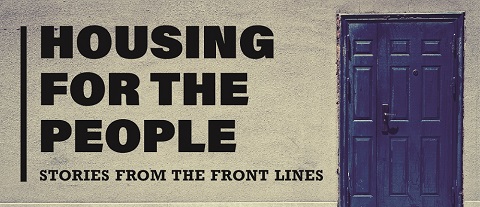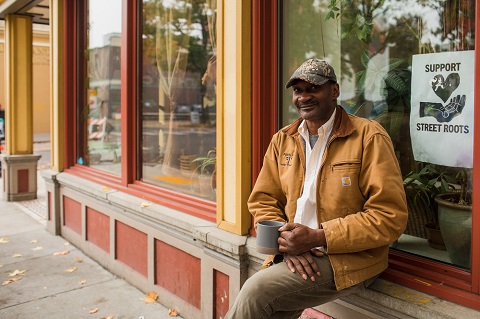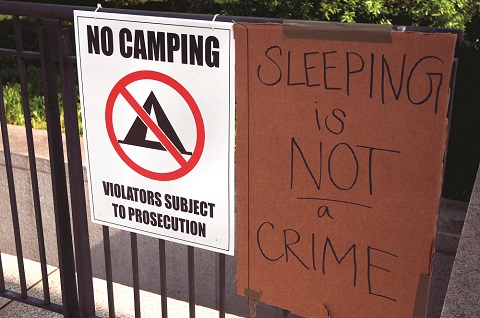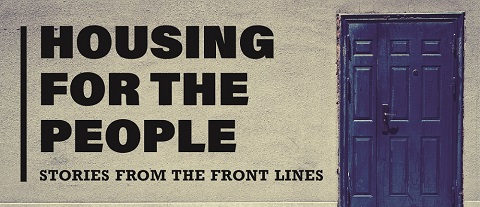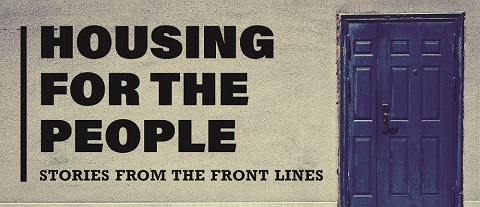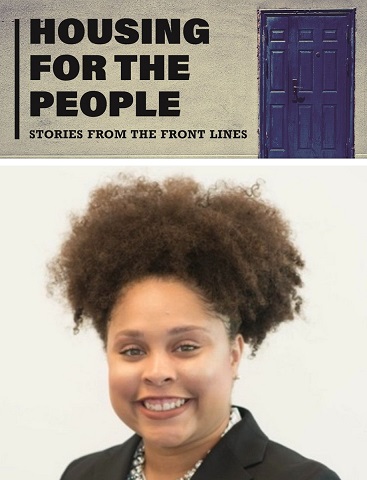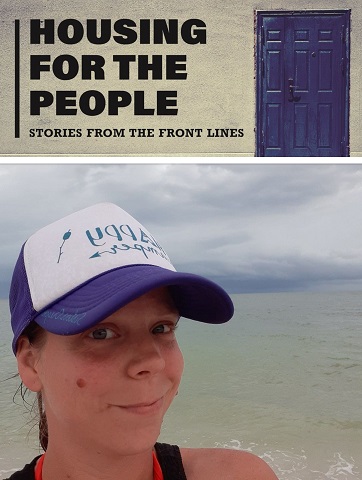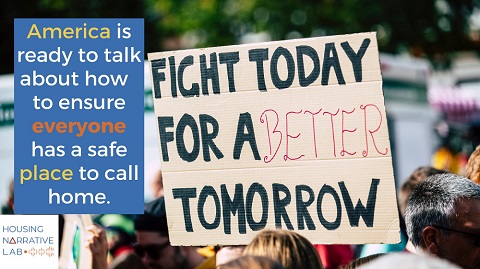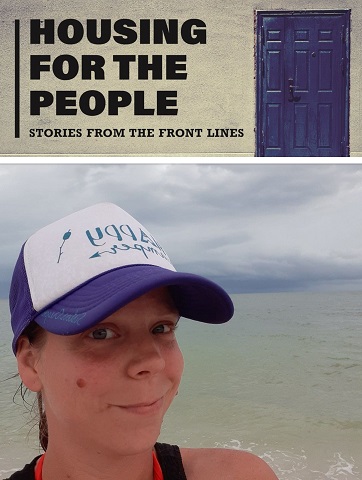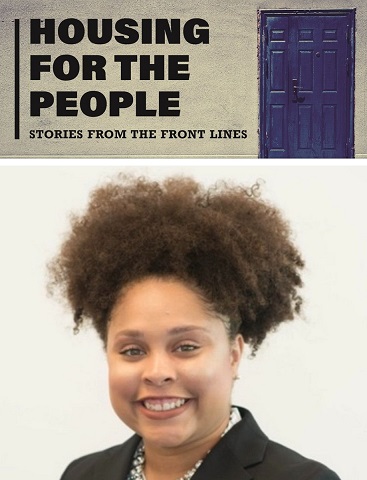As INSP explored last year, Scotland is a bubbling cauldron of imaginative and forward-thinking social enterprises looking to do their bit to tackle some of the country’s overlooked, or simply unaddressed, social problems.
The Big Issue may be the at the forefront of tackling homelessness and poverty, but it sits alongside other creative businesses which channel the work they do into benefitting people living on the streets.
During last year’s Global Street Paper Summit in Glasgow, delegates were treated to an alternative tour of the city by an Invisible Cities guide, who pointed out some things – sights, shelters, businesses and places of note – that, though lesser known to everyday locals, were important to the homeless population.
One of those mentioned was The Blankfaces, a social enterprise fashion label that not only provides a small source of income to the homeless people it works with, but also involves them in the design process of its products, from the inception of ideas to the finished article of clothing.
![The Blankfaces storefront in Glasgow's Savoy Centre. [Courtesy of The Blankfaces]](https://hub.insp.ngo/wp-content/uploads/2019/04/INSP_The-Blankfaces_1.jpg)
Now just over a year old, The Blankfaces is a recognisable streetwear brand with the stories of Glasgow’s homeless community embedded within its prints and designs. Its success over such a short period of time has seen its products being sold across prominent retail outlets, to the opening of a stand-alone store in the Savoy Centre, a Glasgow city centre shopping mall, thanks to a new project pushing to offer retail space to local artists and entrepreneurs.
INSP visited the store – which is a mere hop, skip and jump away from our home – to chat to the 38-year-old founder of The Blankfaces, Gerard McKenzie-Govan. As he spoke passionately about the idea, intrigued customers streamed in and out.
Perhaps in line with the social enterprise’s name, Gerard was reluctant to have his picture taken as the face of the organisation. “It shouldn’t be about ‘look, I run this thing’. It’s more about looking at the people we work with – this is their story. Let’s give this brand to the people who need it, and which it represents, and showcase them,” he explained.
INSP: What is The Blankfaces, and where did the idea for it come from?
Gerard McKenzie-Govan: Essentially, we are a fashion brand working towards the aim of ending homelessness. We see that money has been thrown at the issue for years and years, and it’s not changed – it seems to be getting worse every single day. If you walk down [Glasgow main streets] Buchanan Street or Sauchiehall Street, you can see it. If you open up the newspaper, you can see it. Clearly, what’s being done on a grand scale isn’t changing anything.
About four years ago, I had a little boy, and my thoughts and feelings just changed. I wondered, what if he was ever in that situation? What if he was being prejudged, labelled a junkie or an alcoholic, or this or that, by people who walk past him without even knowing who he was or what he’s been through.
So I started up these classes at the Lodging House Mission [a local support centre for vulnerable, homeless and socially excluded people located near the Glasgow’s iconic Barrowlands music venue] just sitting around talking to people, everyone treating each other like human beings, actually listening to their stories. I’ve done fashion and textiles, and worked in retail for years…
![The Blankfaces store in Glasgow's Savoy Centre. [Courtesy of The Blankfaces]](https://hub.insp.ngo/wp-content/uploads/2019/04/INSP_The-Blankfaces_2.jpg)
That’s your background, right?
Exactly. And hearing these stories, and having that background, I started to think about using art classes and creativity to just get the stories of the people I met there out to everyone.
For me, my wife, and a lot of my friends, when I see someone wearing something nice, I’ll probably ask them where they got it. When people buy from us, they learn about the story behind everything we do – it’s not just about buying a t-shirt. When you look and wear a design on one of our garments, it’s not just a cool picture; it’s that designer, the person who came up with that idea, and their perceptions of homelessness.
We got going with these small scale classes, and thanks to a grant from Firstport [a funding and support organisation for social enterprise start-ups in Scotland], we were able to print 100 of our first design – ‘People Make Mistakes’ [a cheeky twist on the Glaswegian motto ‘People Make Glasgow’] – and even more amazingly, sell them. We started putting that money right back into the classes and the business, and here we are today.
Ok, so you’ve touched on it a little, but what was the spark that meant your background in fashion and your own realisation of the homelessness issue metabolised into The Blankfaces?
I want to break down the barriers that seem to exist of ‘them and us’. There shouldn’t be a ‘them and us’. Until I was about 15, 16, my mum and dad had a little hotel down in [Scottish coastal town] Ayr. We stayed in one of the rooms and my mum, she was a proper Christian, she cared for absolutely everyone. She regularly took in homeless people and she treated them like family. If they were hungry, she’d give them breakfast and dinner – she just cared for people. And my whole life growing up, in a room in this hotel, it wasn’t ‘them and us’. I would hang out with the kids from the families that were homeless and passing through. It wasn’t ‘oh these guys are homeless and then there’s me’. That rubbed off on me.
At that time, homelessness wasn’t like today. Now, it’s rife. It’s shocking – there shouldn’t be people sleeping on the streets in this day and age. There are so many buildings lying around in Glasgow empty, and we’re not doing anything with them. Why can’t we help? Supposedly ‘People Make Glasgow’, this whole big mantra, but if you look at it, people here are not helping those who really need it. We’re just trying to do our little bit, to change those mind-sets and perceptions, trying to re-educate people in the actual reasons behind homelessness and the needs of those experiencing it. Showing people as human beings instead of just another blank face.
The fashion industry is worth billions of pounds each year. If we can help people with the money we make, then great. But more importantly, people buy clothes and people wear them and they talk about them. Everyone needs them. Even if someone says they hate fashion culture, or they don’t care what they wear, everyone has their own style. They wear something because they want to look that way. If they can buy from us, and we’re giving it back to someone that needs it, then great. But, it’s about telling stories. You hear some of them and, I’m not going to lie, if it was me, I’d be in a worse situation than these guys – the strength some people have is amazing.
So how does it work in practice and what’s the design process?
We start by doing a workshop at places like Lodging House Mission – we have big tables out, and volunteers, like students, who come in and sit with the people there over a four-week cycle. We start with writing down your timeline, how you’ve got to this point in your life, and talk about picking out the bits that jump out. Some of the participants don’t want to draw, but that doesn’t necessarily mean they don’t have that creative side to them.
They can tell us their story and we go away and work with that – we have a graphic designer who works with us – and come up with something. Or, you have people like Buddy, whose image is the next one we’re working up – he’s an amazing artist. He’ll sit and draw things and you might not get it. But then he’ll explain the thinking behind it and it’s so powerful. So we try everything. If someone wants to sit down and paint and have an art lesson with us, then we’ll try that. If it’s more to do with telling us their story and then we go away and come back with an image, then we’ll sit back down with that person and say these are the images we’ve come up with. We want to be a brand that people buy because we look good, not just a thing that people buy because they feel sorry for us or the people that we work with. It’s about taking that story and working it up into an image that will sell even in a high end department store, a high street brand where every image has a connective story behind it and a meaning. You don’t get that with any other fashion brand at the moment.
![Homeless participants and Blankfaces volunteers collaborate in one of the social enterprise's creative workshops. [Courtesy of The Blankfaces]](https://hub.insp.ngo/wp-content/uploads/2019/04/INSP_The-Blankfaces_10.jpg)
A really important aspect is getting these outside volunteers coming in and taking the classes. I could do them, but I’m no longer a person who sees a barrier between myself and homeless people. I’d rather get people in that I can say ‘let’s sit down and talk to these people, let’s just have a group discussion, let’s paint together, find similarities between us’. The first time I took a group of students into the Lodging House Mission, one of them asked ‘well who in here is homeless?’. And I’m like ‘well, everybody’. She said, ‘they don’t look homeless’. And so there’s that perception disconnect. It’s breaking down that barrier with her, and breaking down a different barrier with others. Just hearing a personal story, understanding how and why they got to this point in their life, and asking ourselves what we can do to help. We’ve partnered with students at Glasgow Caledonian University who will incorporate their discussions with homeless individuals we’ve linked them up with into their end of year catwalk show – each garment will have a story to it from a homeless person. That’s so empowering.
For any of the people that come up with the design, ten per cent of every garment sold with their design on it, be it a t-shirt, a hoodie, a sweatshirt, goes directly to that person. With the rest of the profits, we are going to be working with ten small grassroots homelessness charities across the UK, to help them on their way. These guys are the front line, actually providing services that are helping homeless people on a day to day basis. So, instead of giving it to the biggest organisations, we work with the wee ones who actually need a leg up, like we did at the start.
How have you benefitted from being in Scotland in terms of getting set up as a social enterprise?
There is a lot out there, in this country, for businesses like us. There are a lot of social enterprises that are working in very niche markets, who can see what I’m seeing in terms of how the issue that they are aiming to tackle isn’t being properly addressed, or perhaps isn’t being addressed at all, and that’s why small businesses like us are important.
Of course, we shouldn’t have to exist. If the people in positions of power were doing things properly, looking after people in society the way they should be, these organisations wouldn’t need to be there. I saw a problem, a need, and that’s why we’ve gone for it on our own. The bottom line isn’t making money or having a thriving business, although those things are important for sustainability – it’s about making a difference to the people you’re trying to reach.
![One of the first Bankfaces designs - the bleeding heart. [Courtesy of The Blankfaces]](https://hub.insp.ngo/wp-content/uploads/2019/04/INSP_The-Blankfaces_3.jpg)
Talk us through one of your most recognisable designs.
The bleeding heart is probably our most famous design. That was Davie, who I met down at Lodging House Mission when I first started, before I’d had the idea for The Blankfaces. I sat down with him and we were talking and his thoughts were: homeless people are seen as a ‘bleeding heart’, they always have their hand out, they’re always wanting something. He wanted to subvert that. He wanted to be treated like a human being, not just someone sitting on the street being felt sorry for, asking why they’re being ignored by people who put the blinkers on and think if they’re not looking at people on the street then homelessness isn’t an issue they have to care about.
We had this symbol and then we were deciding what it would actually look like. We decided to come up with a proper, realistic looking heart, none of this love heart type stuff, something that’s dirty and real because being homeless can be – it’s a difficult experience. When he saw the result, he was so proud. Just seeing that in his face, that this was his idea come to life, was so heartfelt.
This interview has been edited for length and clarity.




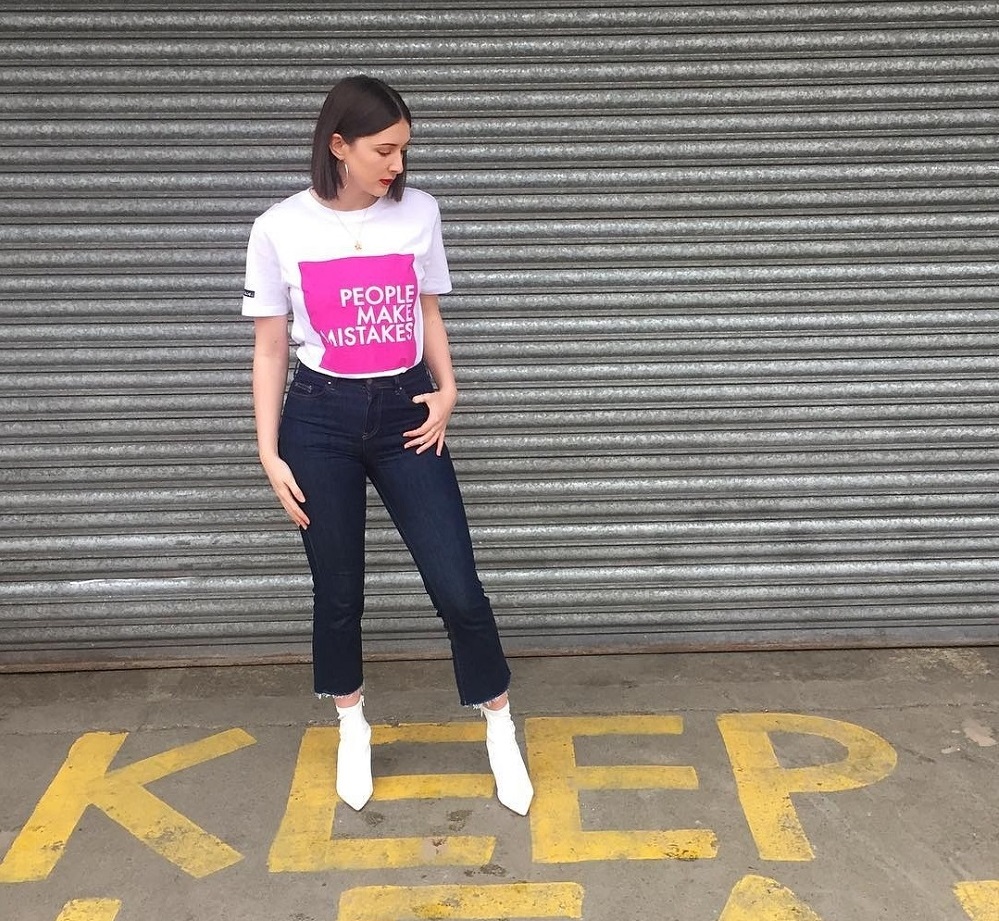
!['Reverse Social Decay' - Some of the most recognisable Blankfaces designs. [Courtesy of The Blankfaces]](https://hub.insp.ngo/wp-content/uploads/2019/04/INSP_The-Blankfaces_6.jpg)
![Some of the most recognisable Blankfaces designs. [Courtesy of The Blankfaces]](https://hub.insp.ngo/wp-content/uploads/2019/04/INSP_The-Blankfaces_8.jpg)

